Devoting a few hours of time each week to vegan meal prep can make your life more nutritious, organized, and a lot tastier. This beginner’s guide tells you everything you need to know, from planning to storage. Plus, it includes tons of recipe ideas to get you started, including a nutritious and hearty one-pot quinoa black bean chili!
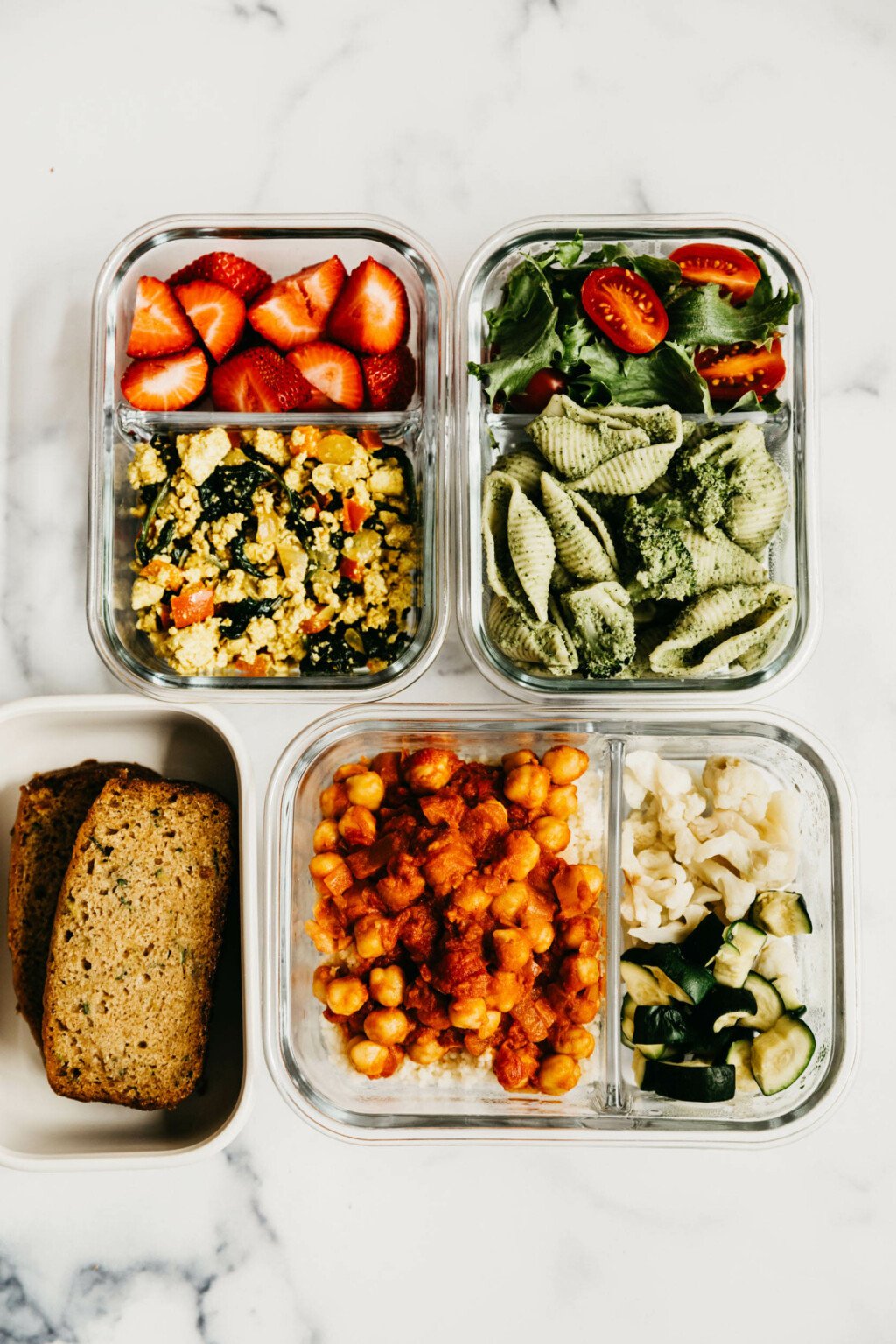
For the past few weeks, I’ve been sharing more about my meal prep process.
On any given week, I might meal prep my dinners, lunches, or breakfasts. Most weeks, I prep at least some components for all three of these meals.
It’s great to chat about the types of foods and recipes that lend themselves to meal prep. Today, though, I’m taking a step back.
What is meal prep? How do you get started with it? How much food does one need to prep, and how do you plan? How long does meal prepped food last?
This is just a sampling of the questions that I’m typically asked when I write about or talk about meal prep.
I’ve learned that a lot of folks love the idea of meal prep, yet feel totally overwhelmed by the details and logistics.
Hence this beginner’s guide to vegan meal prep.
I’ve divided the post into the following sections, all inspired by feedback and questions that I commonly get asked about this topic:
- Meal prep basics
- Planning
- Storage and reheating
- Freezing and defrosting
- My favorite storage containers
- Vegan meal prep recipes
- A meal prep-friendly vegan chili
Meal prep has made my life and self-nourishment so much easier. I’m hoping that it can do the same for you, too.
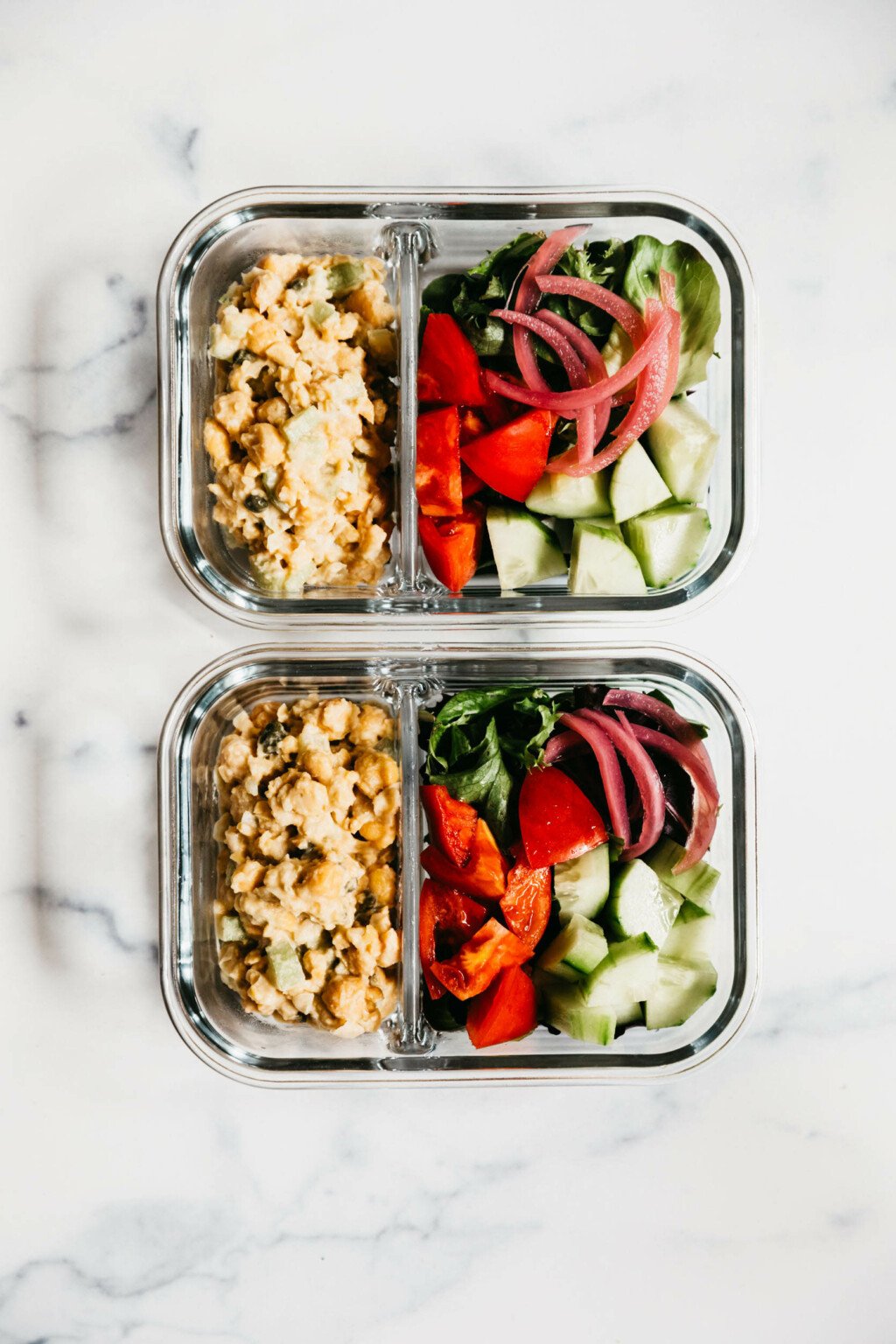
Meal prep basics
What is meal prep, anyway?
First things first: what, exactly, does it mean to meal prep?
Quite simply, meal prep involves making some, most, or all of the food one plans to eat for the week ahead of time.
What’s the advantage of meal prep?
So, what’s the point of making food in advance? Why might it be a better option than cooking day-to-day?
In my mind, the point of meal prep is to cook during the least rushed, fatigued, and stressful moments in one’s week.
I don’t cook well when I’m dealing with any one of those factors: tight time constraints, exhaustion, or stress.
I mess up recipes, including my own. I rush through the process, taking less care than usual, and my food suffers as a result. Sometimes I forget to purchase the ingredients that I need and make substitutions that don’t really work.
More importantly, I don’t enjoy cooking when I’m tired and hungry.
My meal prep isn’t always a joy. Sometimes it’s just functional, the thing I know I need to do. But it’s always more pleasurable than my efforts to cook at the end of a long day.
Here are some other reasons that I like to meal prep:
Variety
I do my best to eat a variety of dishes each week. Like most people, however, I fall into ruts.
This becomes more pronounced when I don’t have a plan. If I need to figure out what I’m making on the fly, I’ll tend to default to the same dishes over and over again.
There’s nothing wrong with having tried-and-true recipes that work. But variety matters, too.
As of 2019, food based dietary guidelines (otherwise known as FBDG) were available for 90 countries around the world. Each one of them stressed the importance of variety.
Why? Because a greater variety of foods ensures a higher overall and more diversified intake of nutrients.
Case in point: we know that the colors of fruits and vegetables are due to plant-based pigments that are associated with protective benefits against aging and disease. These pigments are phytonutrients. Each color—green, purple, red, orange, and so on—is associated with different health benefits.
The reason we’re told to “eat a rainbow” is because doing that allows us to take in more phytonutrients overall.
I’d like to pretend that I always “eat the rainbow” in a given day, but I don’t. When I don’t have a plan, I tend to eat the same veggies (broccoli, carrots, zucchini) and fruits (apples and bananas) again and again.
When I meal prep, I actually sit down and give some thought to what I’ll eat in the week ahead. In doing that, I diversify my produce.
Meal prep also helps me with culinary variety. When I pick a few dishes to make for the week, I’m thinking about variety of texture and flavor as well as color and nutrition.
Budgeting
Groceries can be expensive in the first place, and this only becomes more true with inflation.
Even so, I always spend less on food for the week when I meal prep.
This is because I’m intentional with my shopping. I don’t make impulse buys. I don’t spend money on ingredients that end up going to waste because I didn’t use them up quickly enough.
When I make food for the entire week ahead, I think carefully about what to purchase. I stay focused on what I need, rather than getting distracted by enticing (but sometimes pricey) new vegan products at the store.
Organization
There are many areas of my life where I’d like to be better organized. Meal prep, thankfully, has allowed me to stay organized when it comes to cooking.
This is true even if I have a week in which the days seem to fly by in a blur. I may lose track of many things, but my meals are taken care of.
Reduced decision fatigue
Decision fatigue is a weight that more and more of us are carrying as we navigate the responsibilities in our lives.
It’s not always possible to avoid decision fatigue, but there are strategies that can assist in managing it.
The strategy that works for me is to make decisions before making them becomes urgent. Without urgency and rush, I can apply more clarity and thoughtfulness to my choices.
Meal prep helps with this. It also reduces the number of choices that I need to make. When I commit to two or three recipes for the week ahead, I eliminate excess deliberation.
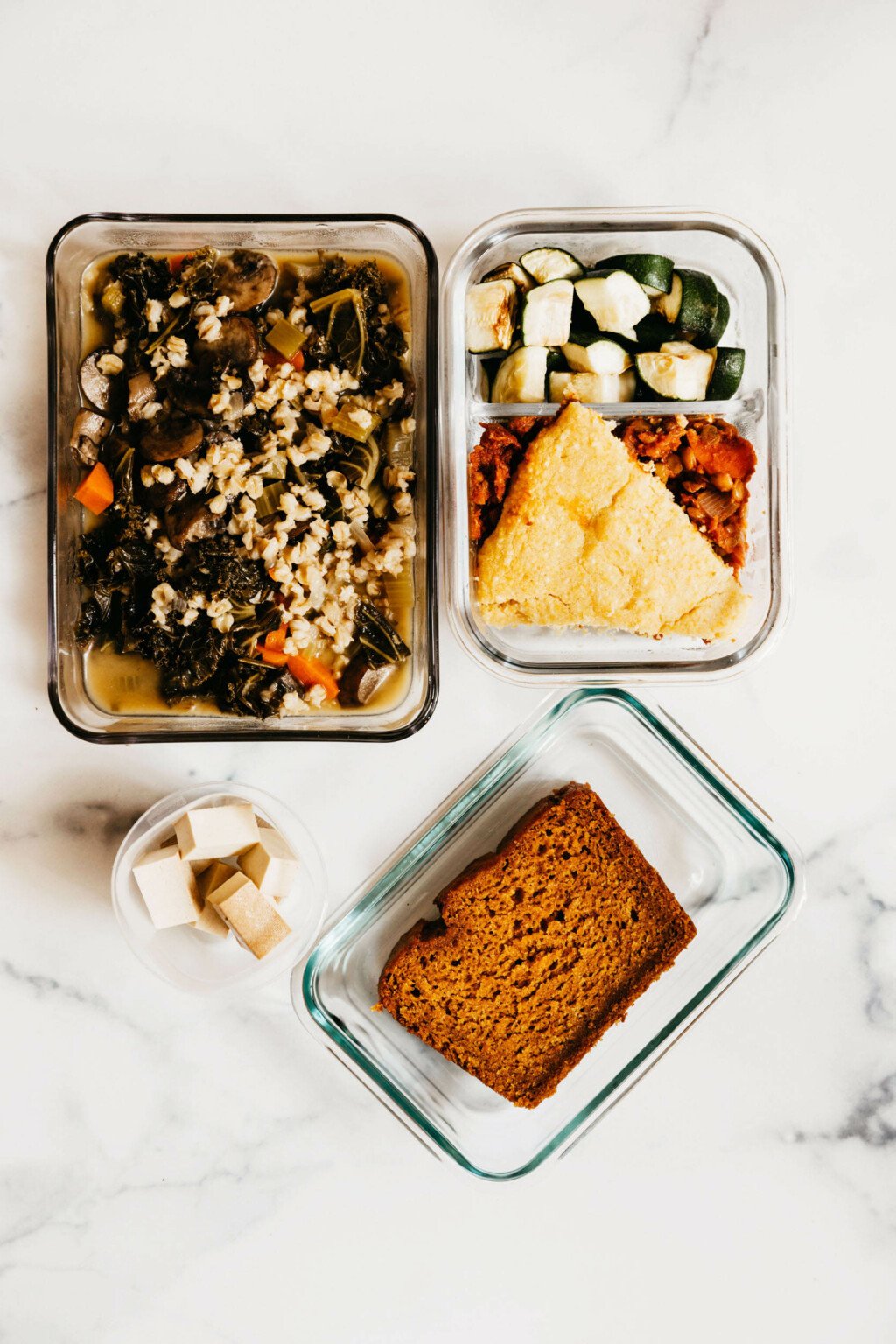
When should I do my meal prep?
You can choose to meal prep over the weekend, if your work life gives you weekends off.
If you have a work, academic, or parenting schedule that gives you other days off—Mondays, for example—then you can meal prep on Mondays.
In essence, you devote some of the free time you have to make-ahead cooking. It can happen when you want it to happen.
How much food do I need to make?
That’s up to you. You can prepare nearly everything you plan to eat in the coming week, or you can make one dish that’s a good multitasker.
Most of the time, I do extensive meal prep over the weekend or on Thursdays. (Thursdays are a day on which I don’t see my nutrition clients as a dietitian.)
My meal prep is usually on the more comprehensive side. I prepare most of my lunches and dinners ahead of time, and sometimes I make my breakfasts in advance, too.
Of course, I don’t make every single thing that I’m going to eat in advance. I intersperse simple, quick eats into my week as well. That might be a bowl of oatmeal for breakfast or a sandwich for lunch.
When I just can’t or don’t want to meal prep, I skip a week. I defrost things that I’ve made previously, or I have a week of simple food: sandwiches, pasta with marinara sauce from the freezer and some Gardein meatballs, skillets with a grain and a bean.
Having a meal prep habit doesn’t mean that you need to do it every single week. It’s a flexible ritual that should make life less stressful, not more.
How much time will it take?
When I was writing The Vegan Week, one of my recipe testers told me that she appreciated the fact that I was honest about how long it takes to meal prep.
I was grateful for that feedback.
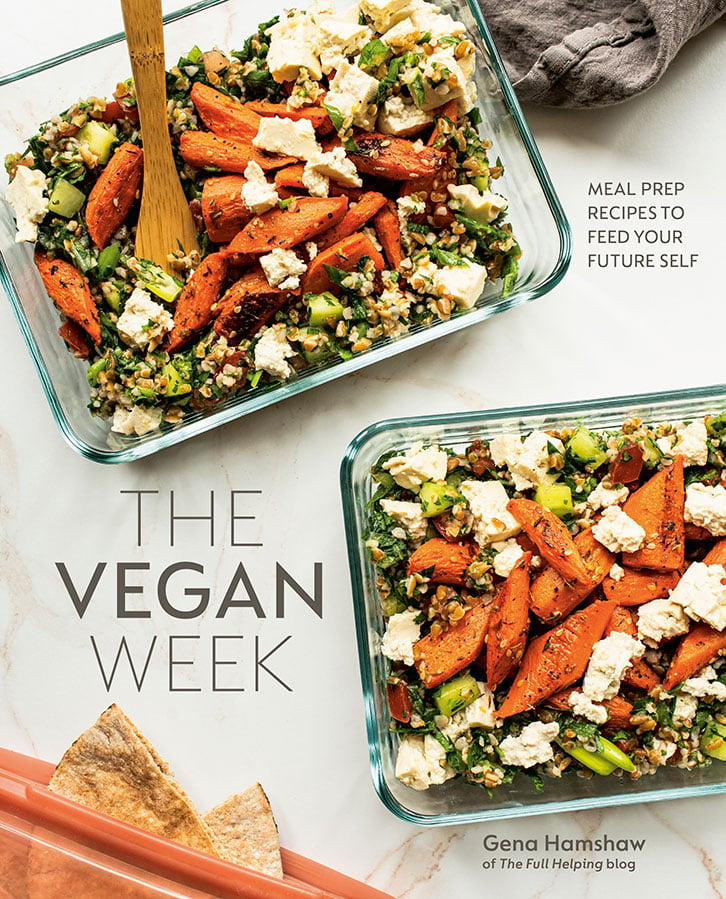
The Vegan Week
Embrace the joy of eating homemade food every day with the hearty and wholesome recipes in The Vegan Week.
Whether you have three, two, or even just one hour of time to spare, The Vegan Week will show you how to batch cook varied, colorful, and comforting dishes over the weekend.
Listen, I wish I could tell you that my vegan meal prep only takes me an hour or two. But the reality is that it usually takes me about 3-4 hours. This includes prepping before I cook, cooking itself, and putting everything that I’ve made away.
The good news is once again that you can choose to do more or less. I’m happier when I make more food upfront and have less to do during the week.
Of course there are some weekends when I have fun plans and only limited time for meal prep. If that happens, I just do a little more cooking during the week.
Something is always better than nothing. If all you have time to do is make one salad dressing, a simple vegan protein, or a cooked grain, that’s great! You’ll be able to use those components in a number of ways as the week goes on.
Planning
Now that we’ve covered what meal prep is and how it works, let’s chat about planning.
Planning weekly meal prep can be broken down into steps.
1. Think about how much food you need for the week
This sounds straightforward, but actually, it’s easy to underestimate. I often finish my make-ahead meals more quickly than I thought I would.
For the most part, though, I’ve learned that 2 recipes, each making about 4 servings, can give me five days’ worth of lunches and dinners.
Within those days, I alternate my prepared food with some of the simple options I mentioned above, like vegan sandwiches or frozen meals.
If your family’s needs are essentially triple of what I eat in a week, you have choices. You can make two recipes, like I do, and double them so that there’s more to go around. You can make an additional recipe. And you can also alternate meal-prepped options with your own favorite simple and convenient standbys.
Thanks to vegan meal prep, you’ll have more time to be present with family, or with yourself, on weeknights.
2. Choose your recipes
Sometimes readers ask me how I choose the recipes that I include in my meal prep.
Most weeks I just make whatever I’ve been craving. Sometimes I’m inspired by produce that’s just coming into season. At other times, there’s a recipe I want to test for the blog or revisit from a cookbook.
You might choose your meal prep recipes based on requests from your family. You may have health considerations that influence what you’d like to prepare.
Whatever your deciding criteria are, just choose a couple of recipes and roll with them.
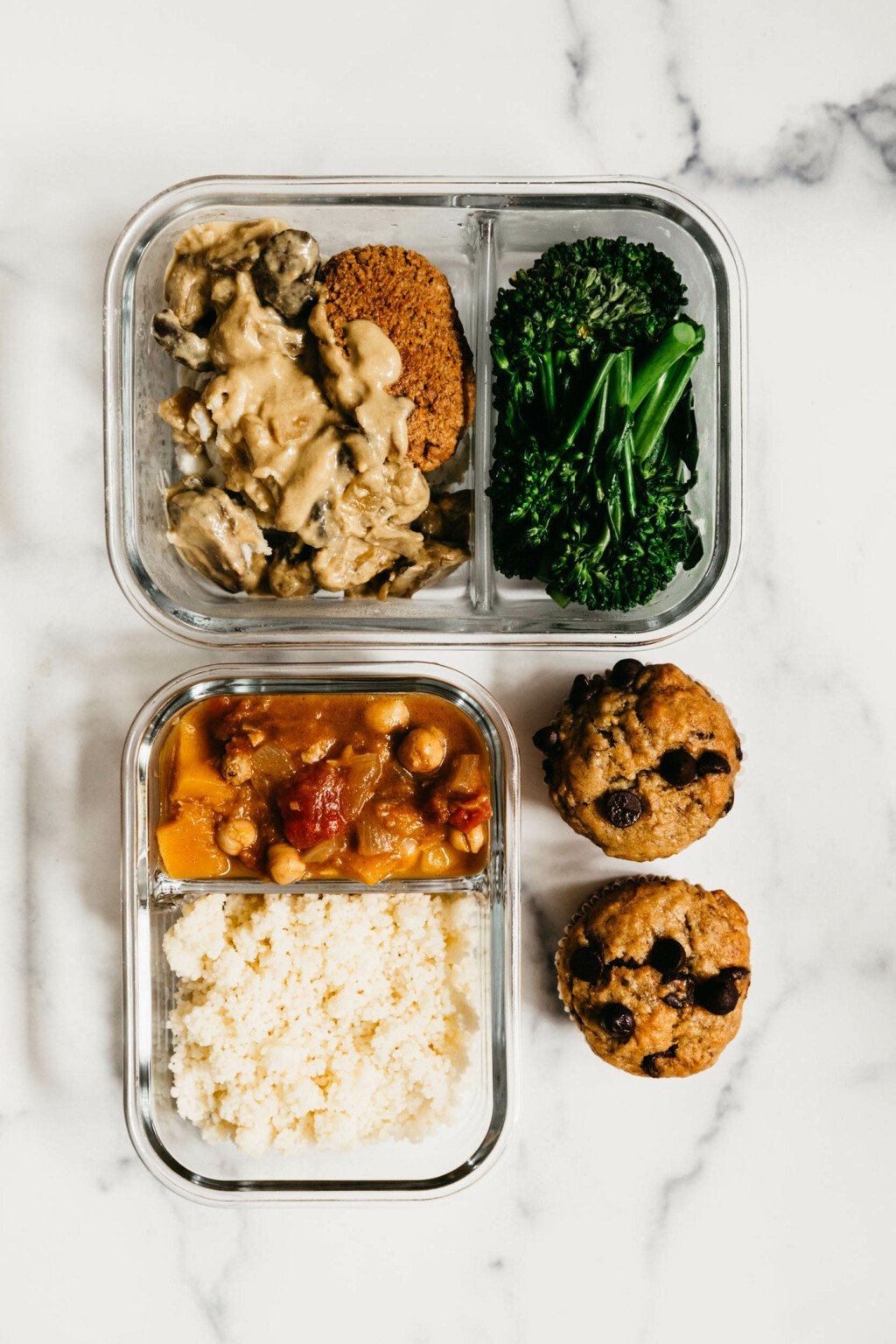
3. Choose some not-recipes
After I pick the recipes that I plan to make, I also give a little thought to basic staple foods that I want to have around for the week.
This can look like:
- Store-bought sandwich ingredients
- Fresh fruit for snacking and to eat with breakfast
- Veggies (fresh or frozen) for vegetable side dishes
- Any pantry items that need to be restocked
- Snack foods
- Frozen foods/products I want to have around
Again, my two or three meal prep recipes won’t take care of all of my food needs for the week. So I stock up on foods that will fill in the gaps.
4. Make a grocery list
Once you know what you want to make, you can create a grocery list around it.
My grocery shopping list is divided into two sections. One is for the ingredients I’ll need for the 2-3 recipes I’m making.
The other is a list of those staple foods that I mentioned above. I add to it household items and cleaning supplies.
5. Shop
Once the list is made, it’s time to shop.
I usually get my groceries at a nearby Whole Foods. I rely on their 365 Everyday Value line for a lot of my staples (grains, canned beans, and so on). If I can, I get to the farmer’s market.
That’s just what works for me. Shopping can happen wherever and whenever is most economical and convenient for you. All that matters is that you have supplies before it’s time to cook!
5. Cook
Cooking is the time-consuming step in meal prep. But it’s easier and more efficient when you have a plan, which is what meal prep will afford you.
I usually plan what I’ll be making on Fridays, shop on Saturday morning, and cook on Saturday and/or Sunday. If I meal prep midweek, I plan and make a grocery list on Wednesday night after work. I shop and cook on Thursday.
6. Store
Once your food is prepped, you’ll be ready to store it.
One of the concerns that people express to me most commonly when I write about meal prep is that they’re afraid of the prepared food going bad.
While I understand this concern, a great many leftovers will keep in an airtight container in the fridge for up to four days. Some can keep for up to five days.
If you prep on a Saturday, your food will be good for eating until Tuesday or Wednesday. You can freeze some of it and defrost later in the week to keep everything optimally fresh. When I meal prep, I almost always freeze half of what I’ve made right away.
Speaking of, there’s a lot to say about safe food storage, freezing, and defrosting.
Storage and reheating
Meal prepped portions of many vegan soups, casseroles, pasta dishes, bowls, and other ingredients can be stored in airtight containers in the fridge for up to 4-5 days.
Of course, this is just an estimate. Always pay attention to smell and taste with leftover food. If you notice any off odors or flavors, it’s best to err on the side of safety. The FoodSafety.gov FoodKeeper app is a helpful reference tool.
When you reheat food, the goal is to heat it to a minimum internal temperature of 165F throughout. If you’re not sure, a probe thermometer makes it easy to know whether you’ve heated food adequately.
Freezing and defrosting
Many pastas, soups, stews, cooked grains and legumes, cooked vegetables, desserts, and dressings or sauces can easily be frozen. Freezing times vary, but most of the recipes on this site can safely be frozen for at least 6-8 weeks.
The most foolproof way to defrost food safely is in the fridge. But you can also microwave food directly from frozen, using your microwave’s defrosting setting. And you can safely cook food directly from its frozen state.
My favorite storage containers
If you get into a regular meal prep habit, you’ll need some containers to help store your creations.
I’ve accumulated a lot of meal prep containers! Some have worked better than others. Here’s my list of favorites:
Divided containers
- Mepal medium bento box
- Pyrex 3.4 quart bento box and 2.1 quart bento box
- Mepal duo lunch box
- Lunchbots trio container
Containers for salads and bowls
Storage containers
Snacks & accesories
- W&P utensil set
- W&P porter dressing containers
- Stasher snack bags and sandwich bags
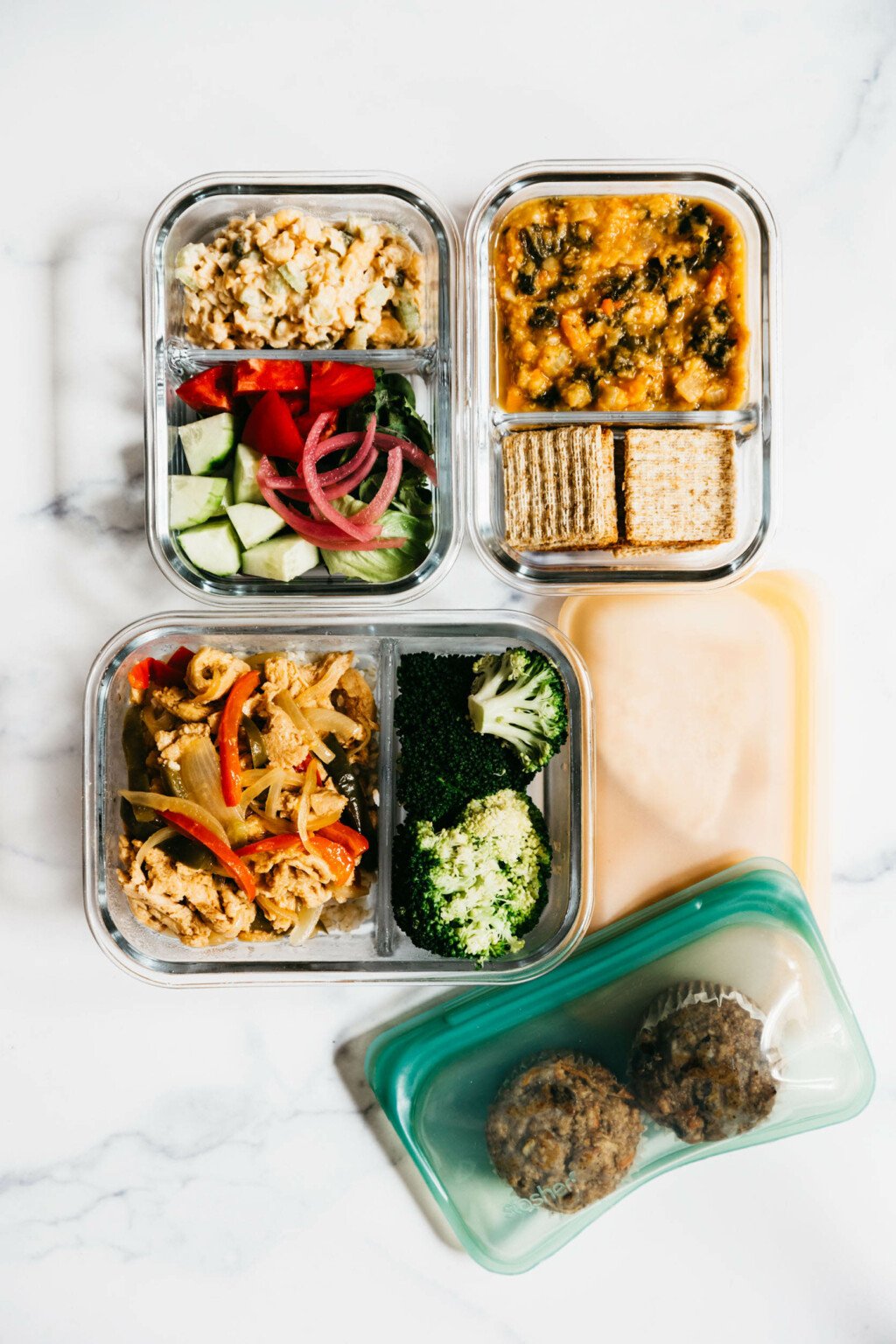
The best vegan meal prep recipes
For vegan meal prep meal ideas that are mealtime-specific, check out:
Apart from this, there are some recipes that I think are particularly useful for meal prep:
- Sauces and dressings, for instantly jazzing up simple bowls, salads, roasted veggies, and more
- Dips and spreads, for snacking and sandwiches
- Simple proteins, for adding to to salads, wraps, burritos, and bowls
- Vegan one-pot meals, for easy dinners and lots of leftovers
Here are some of the ones that I prep most often.
Sauces & Dressings
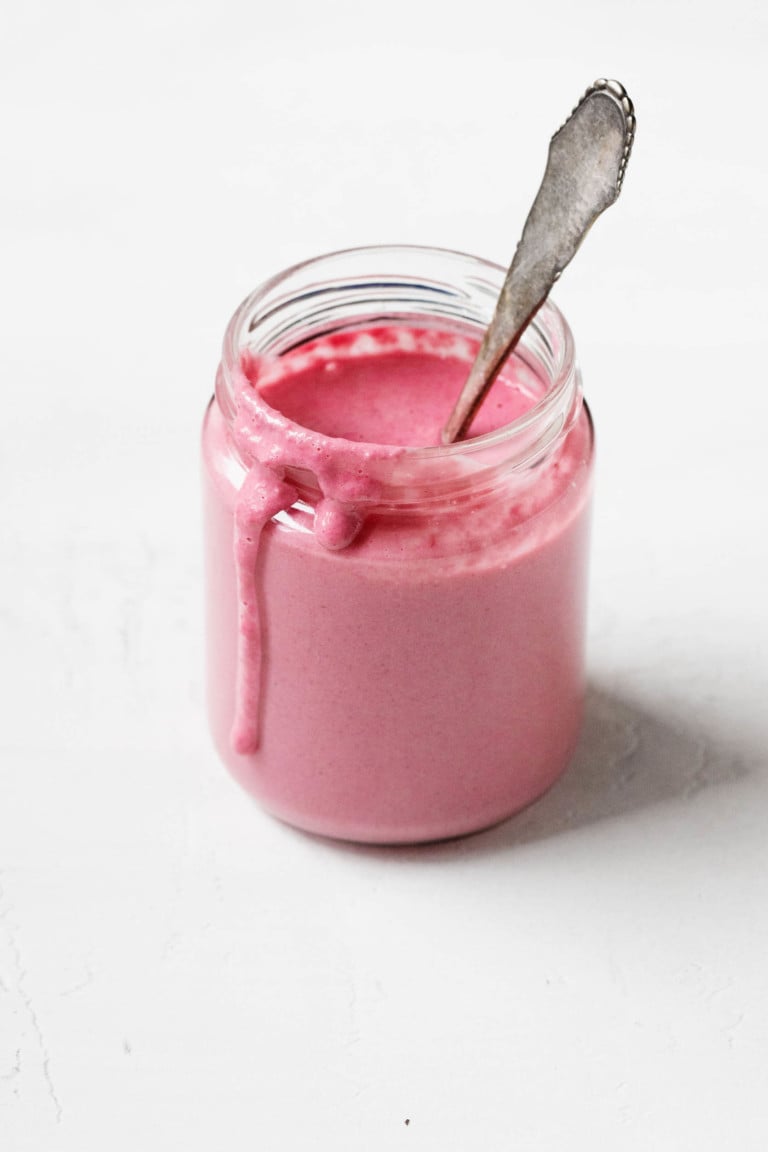
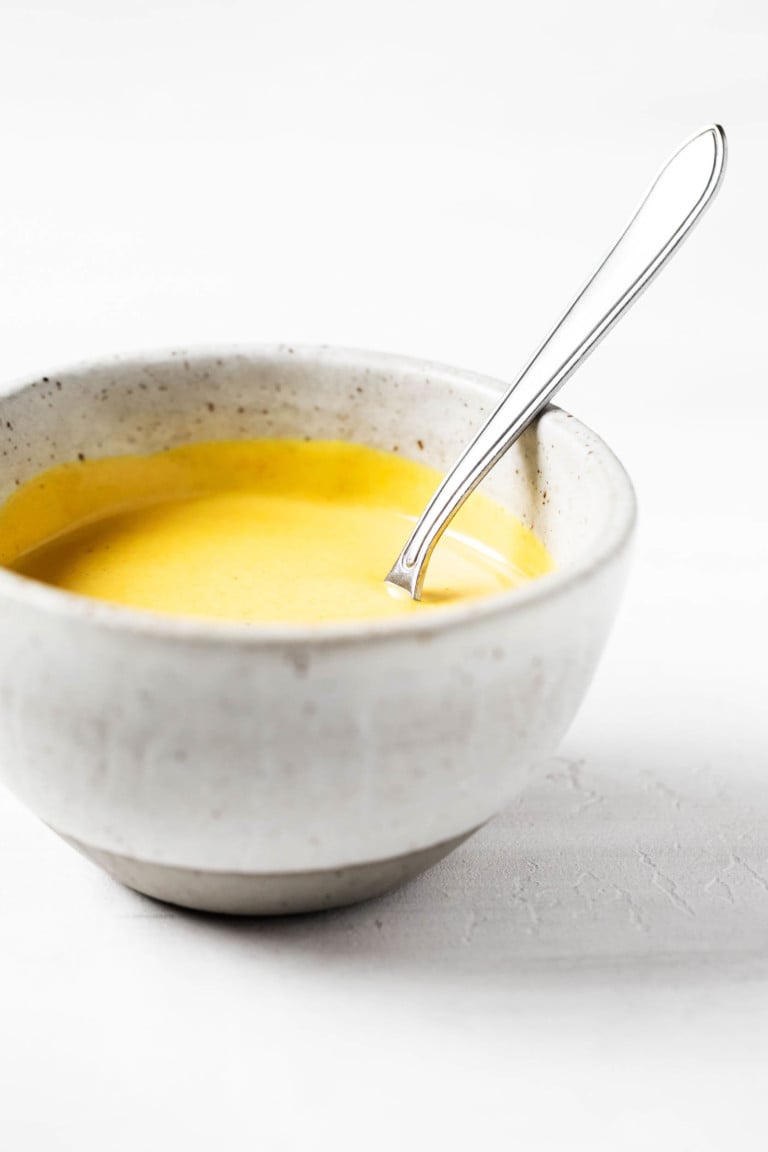
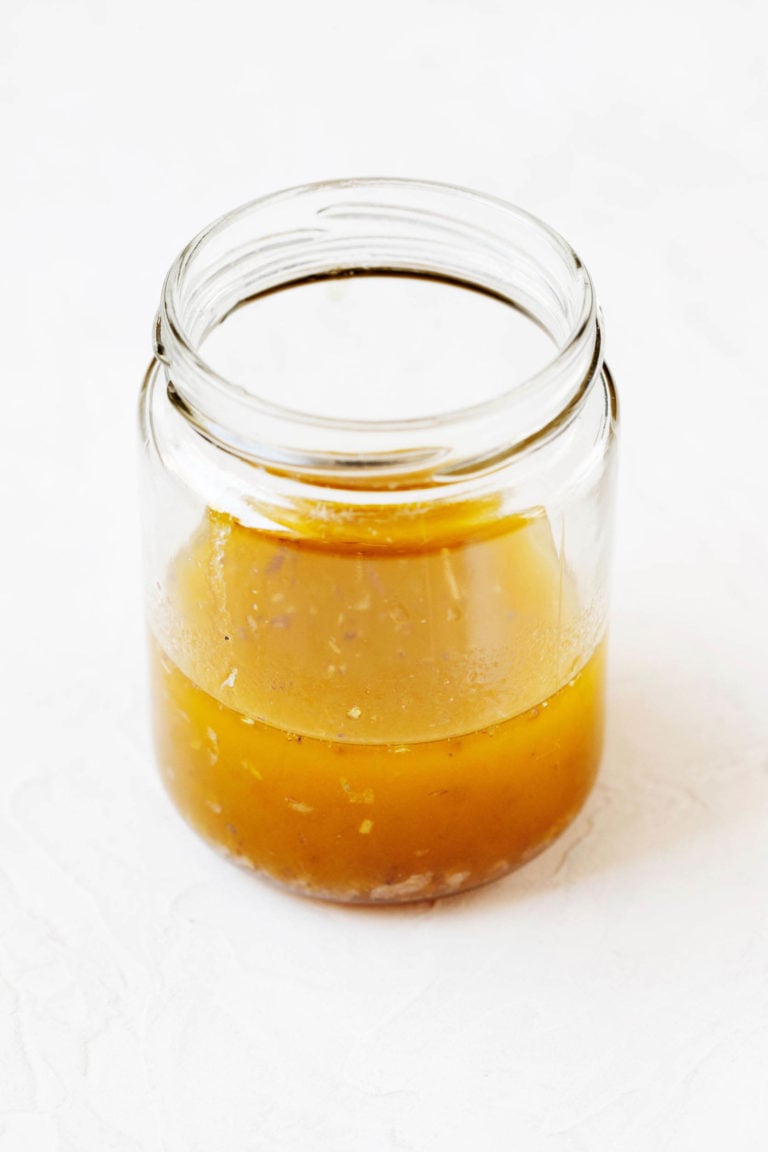
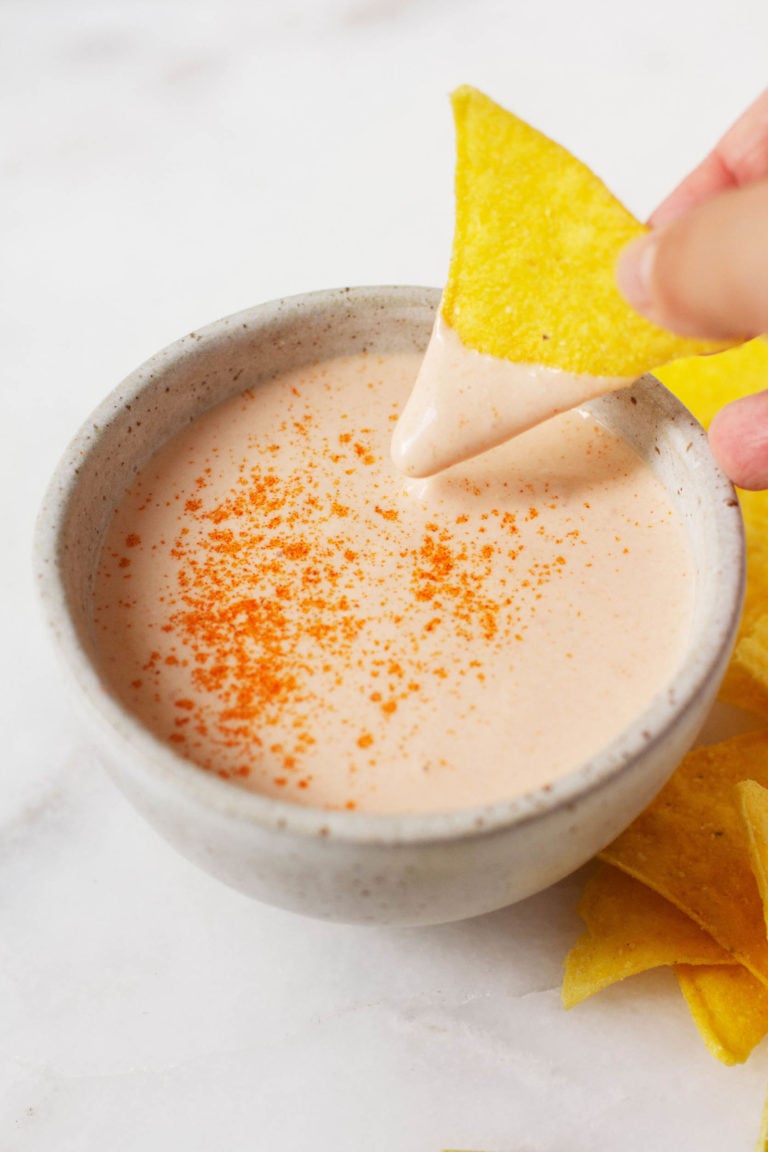
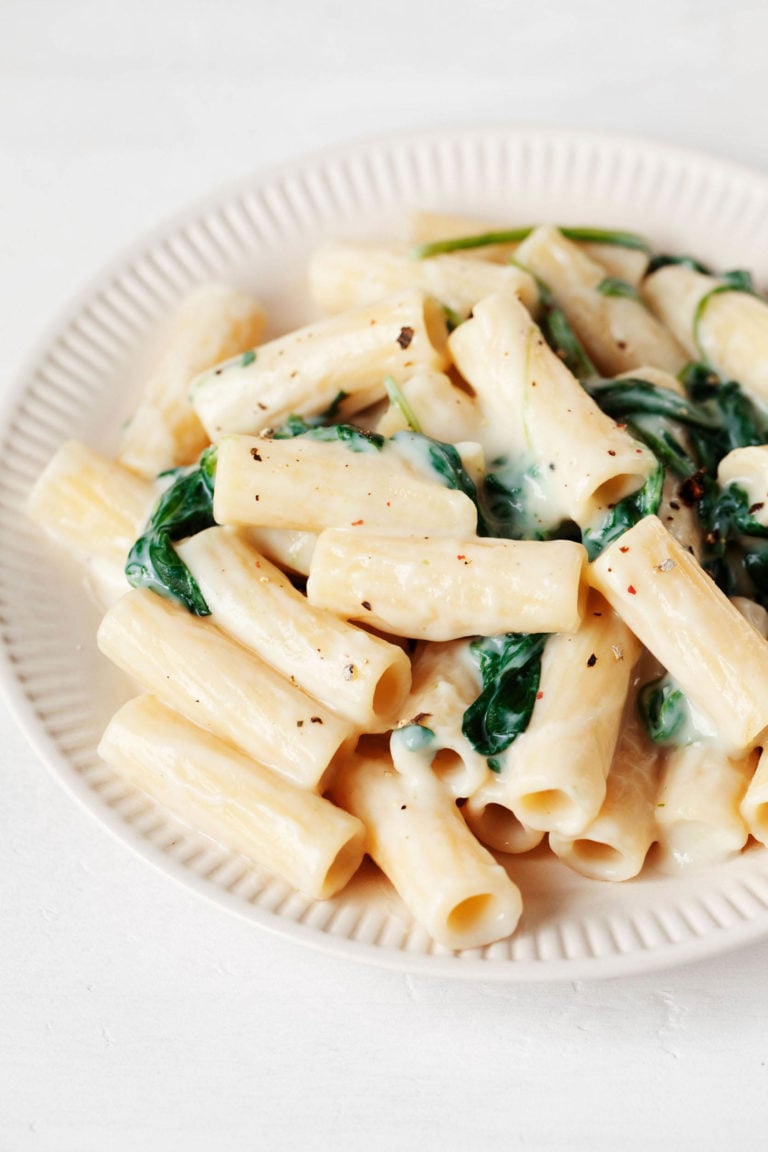
Dips & spreads
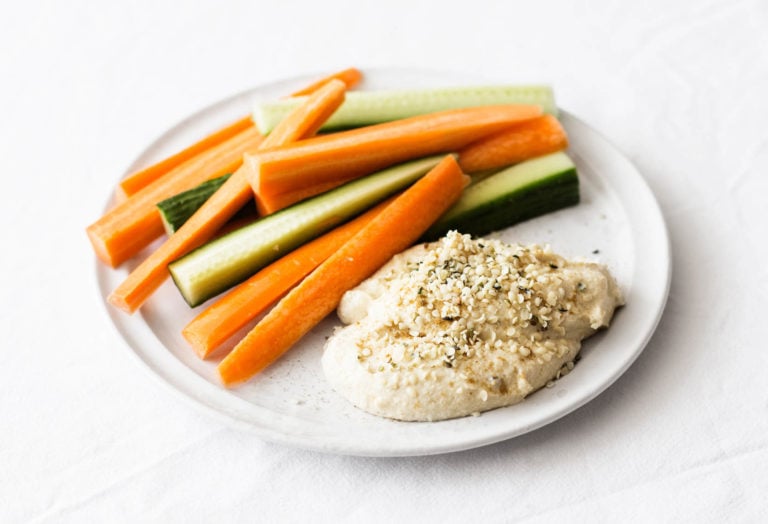
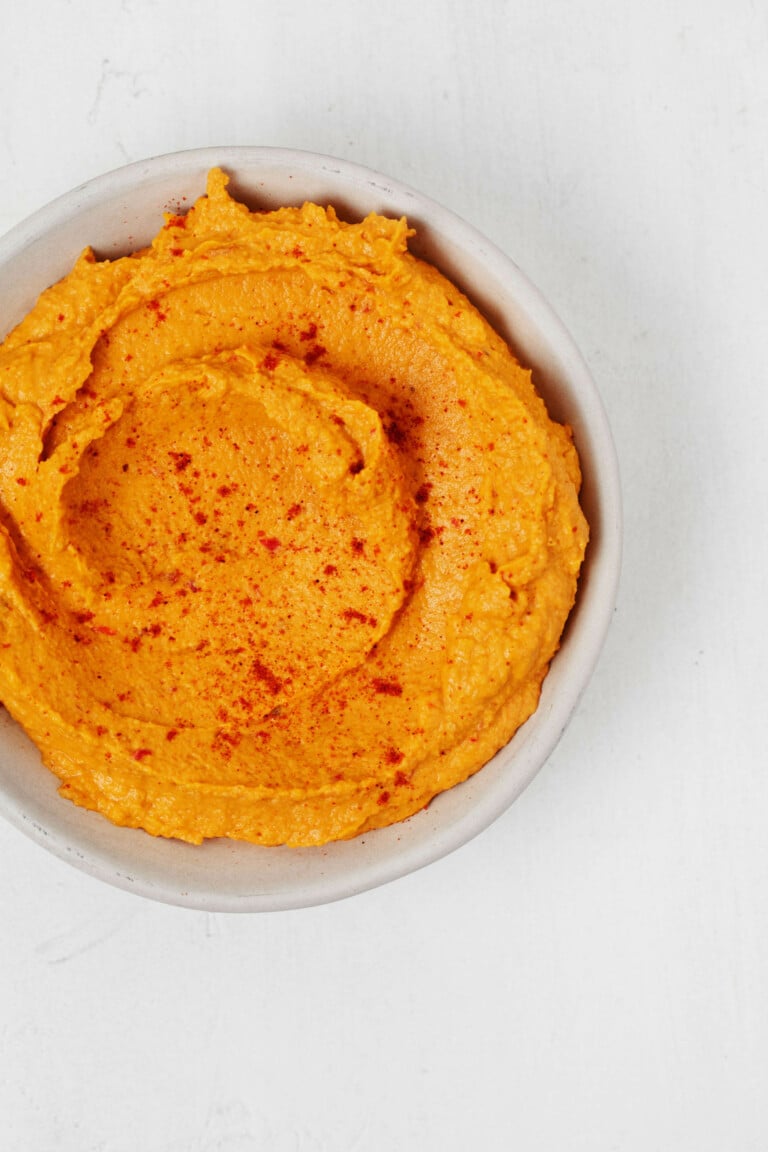
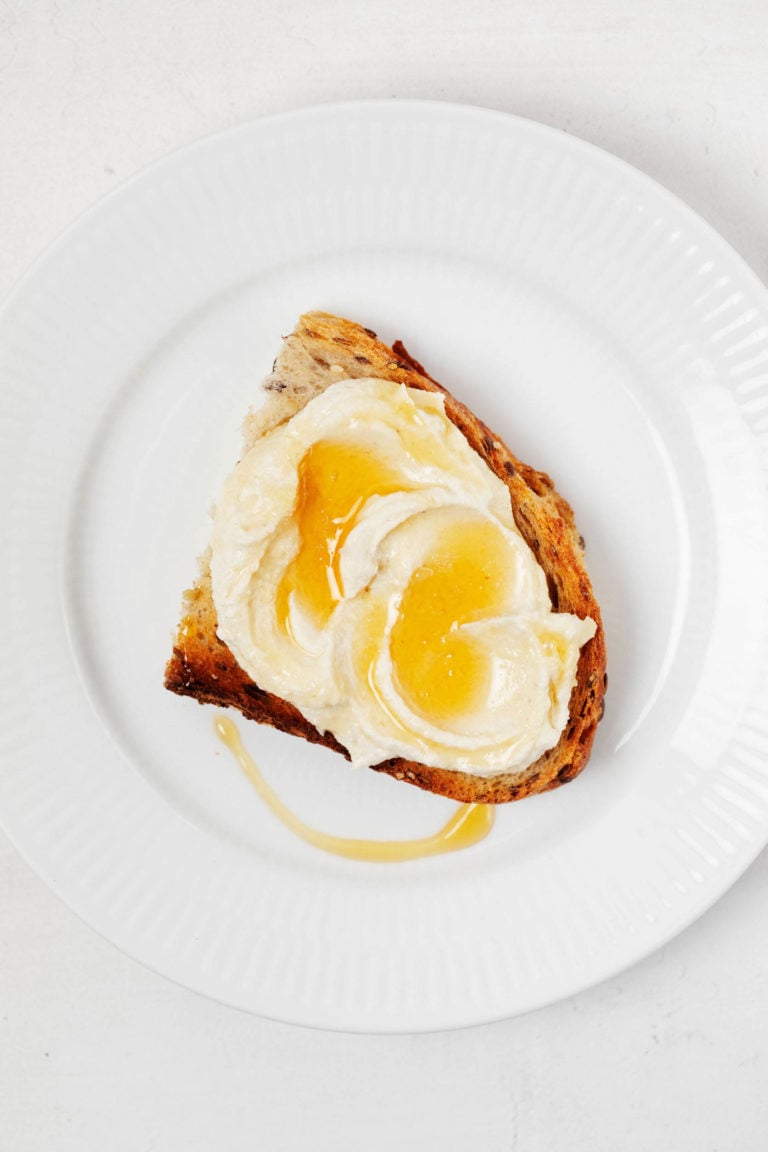
Simple Proteins
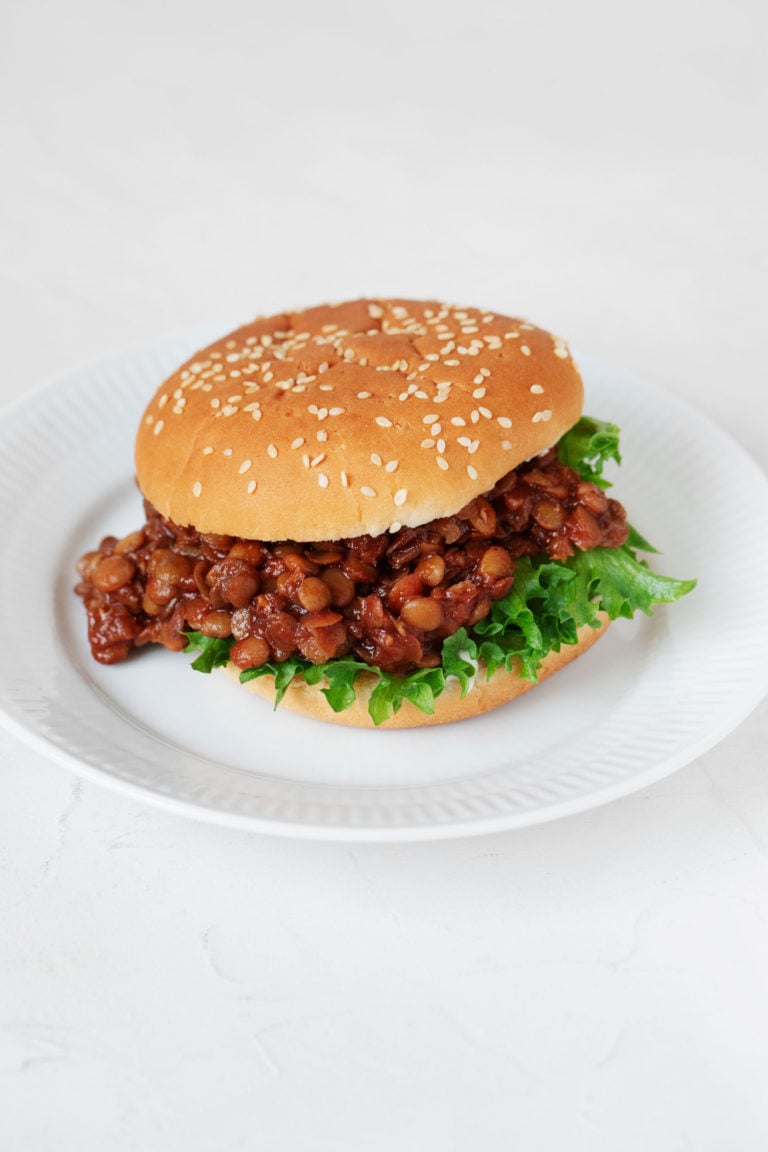
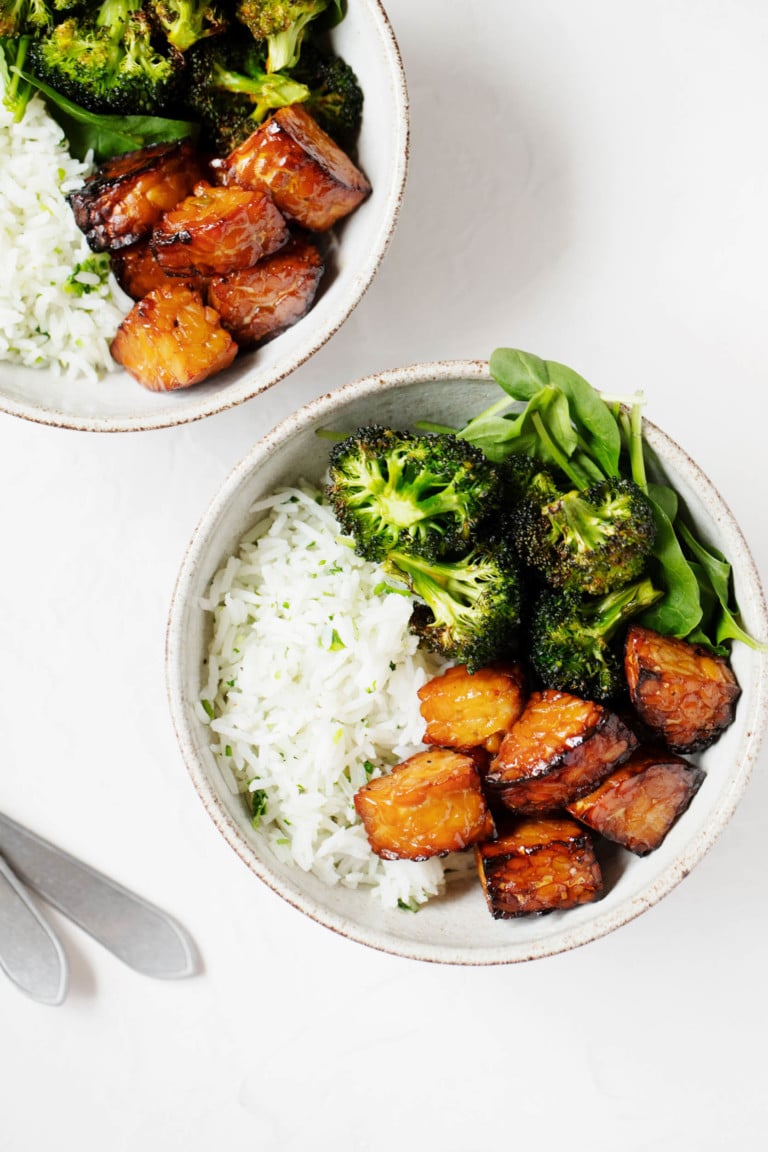
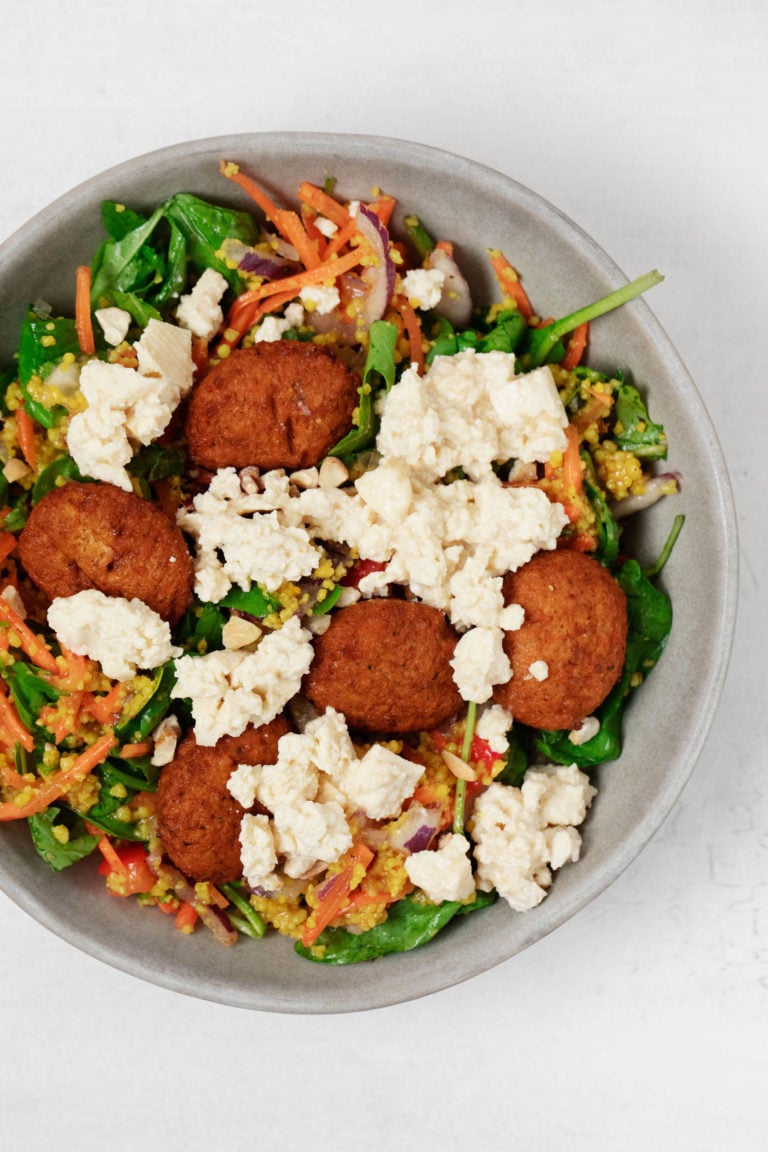
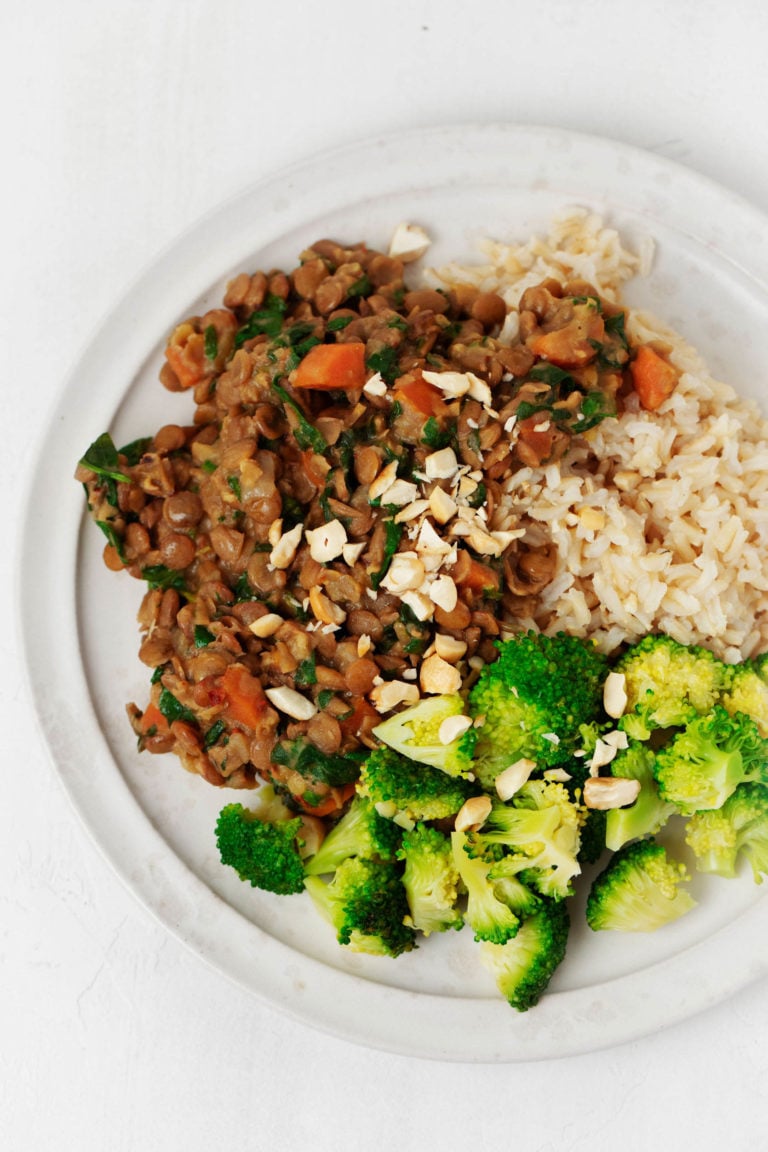
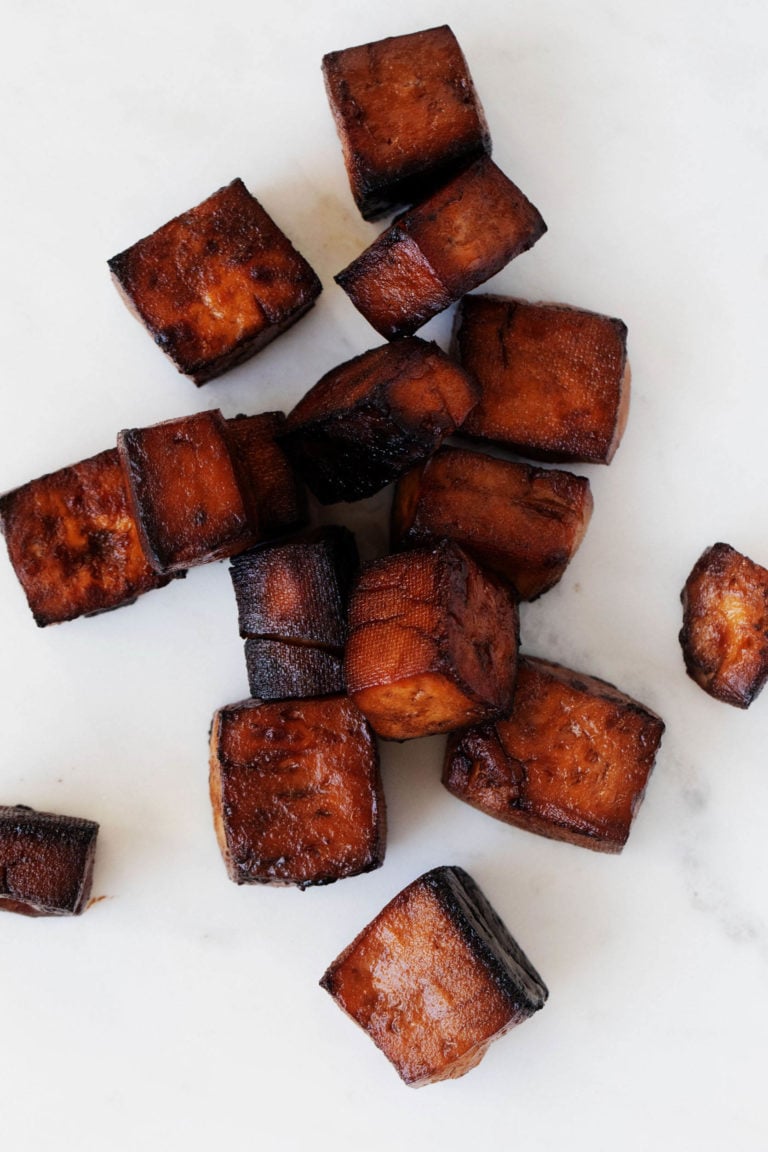
Vegan one-pot recipes
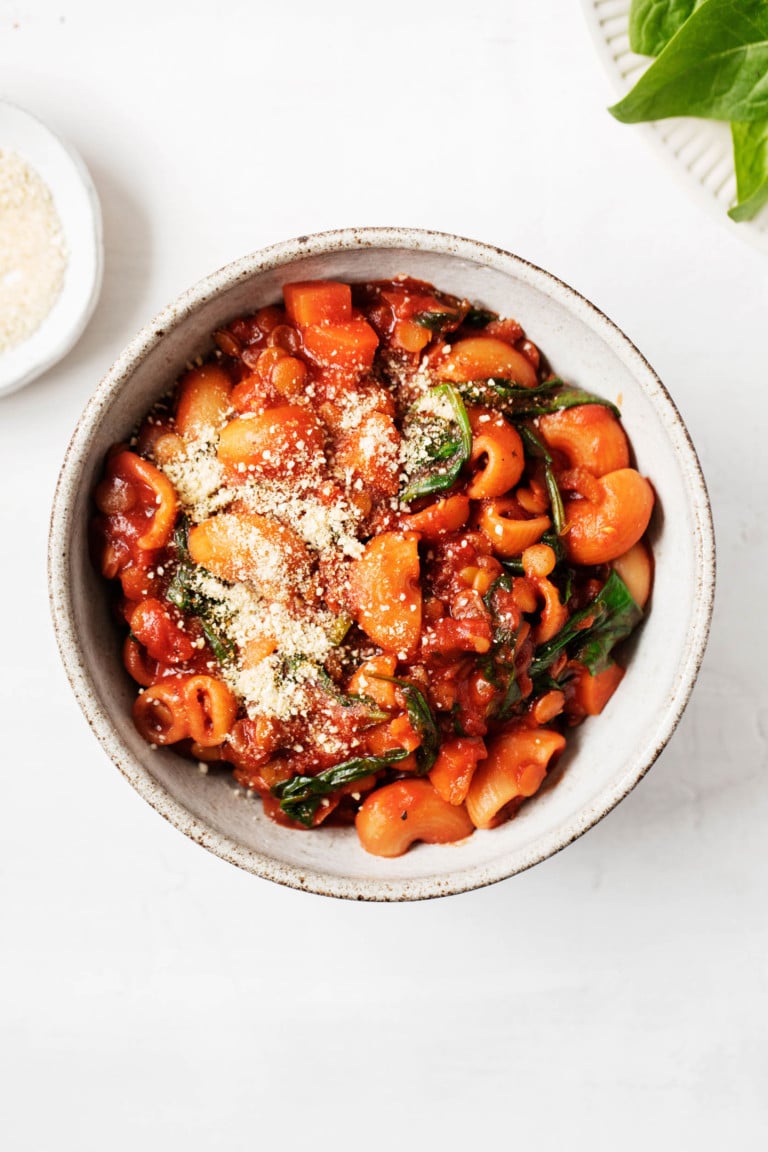
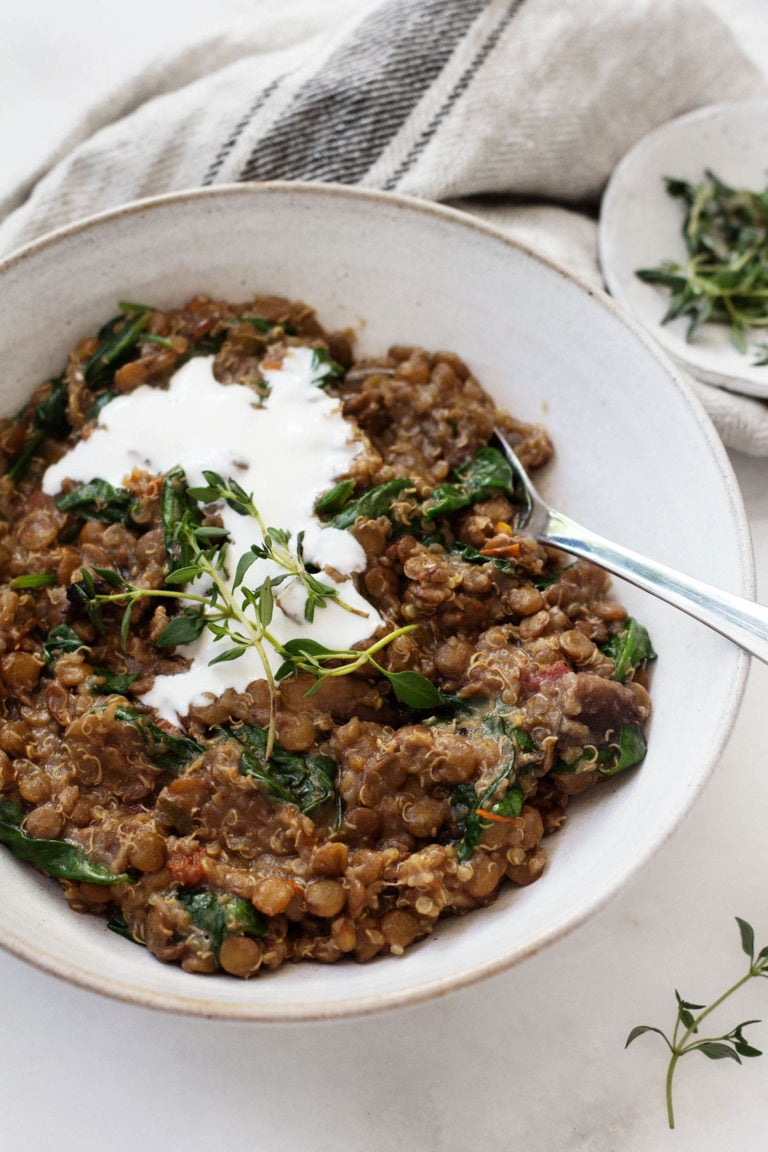
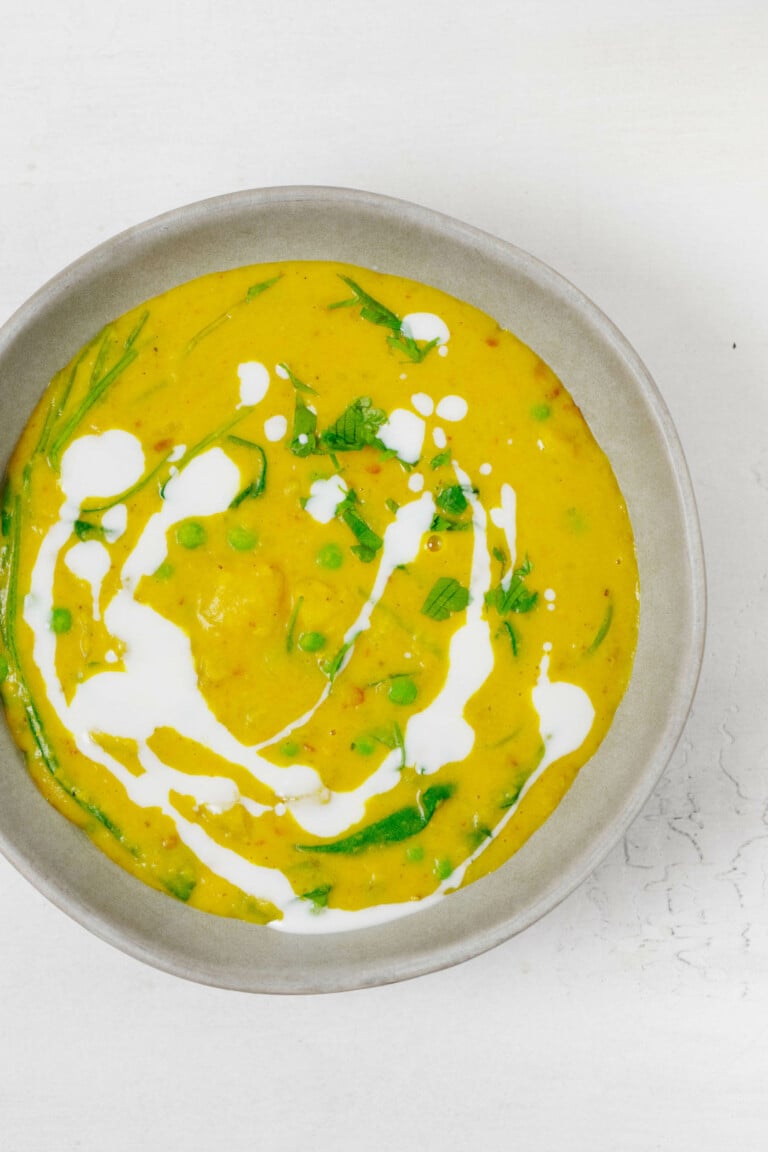
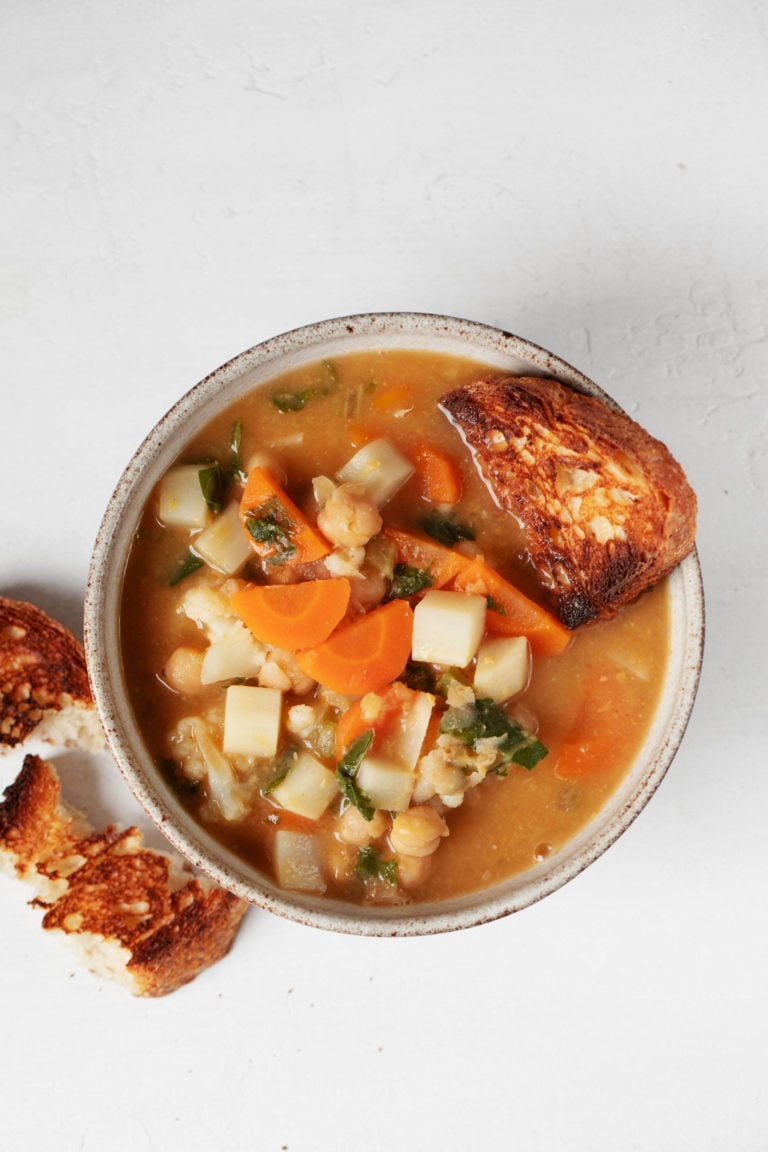
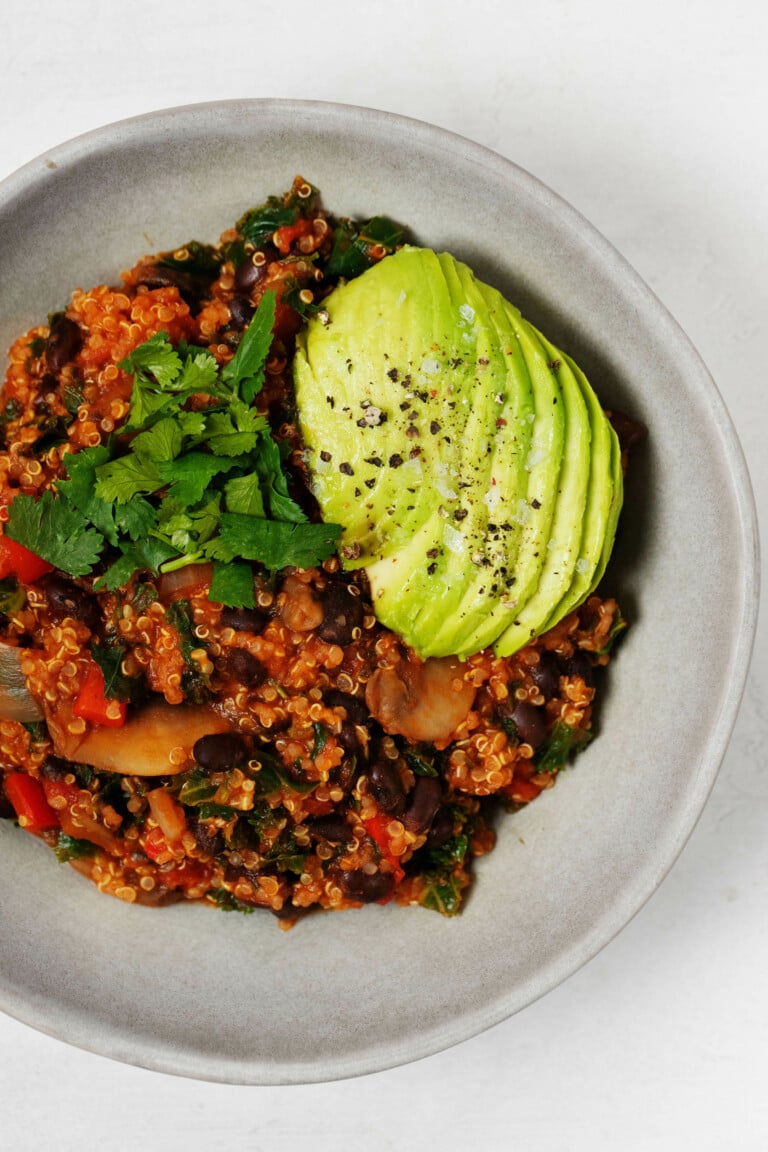
A meal prep-friendly vegan chili
A few more words about that chili!
This guide is intended to be a starting place for those who are curious about meal prep. And black bean quinoa chili is a perfect recipe to start with.
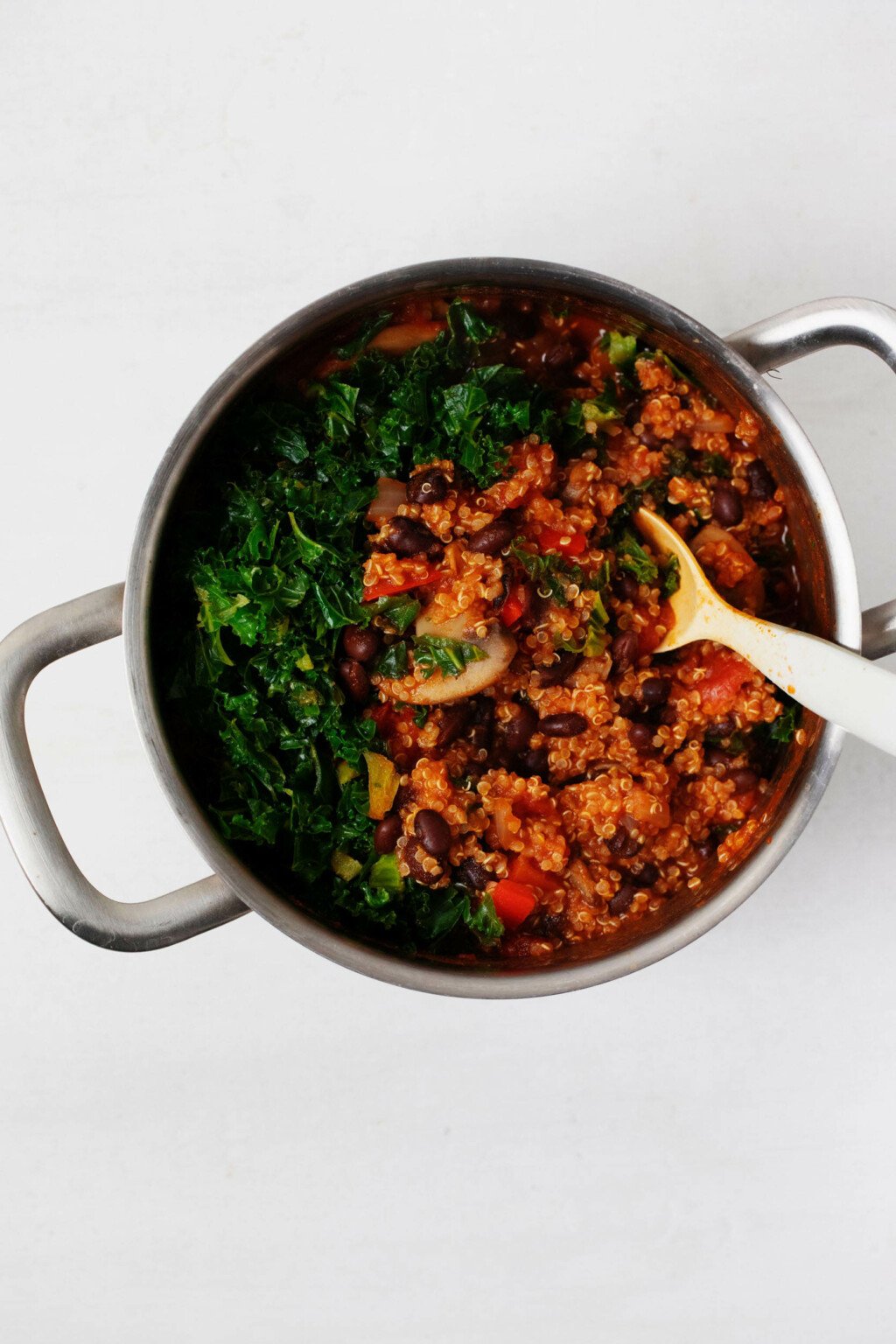
The chili delivers what a great meal prep recipe should:
- Solid nutrition
- Easy preparation
- Lots of portions for storage and freezing
- Budget-friendly
- Adaptable
By adaptable, I mean that there are many ways that you could serve the chili:
- With a slice of vegan cornbread
- With a salad or other vegetable side dish
- As filling for breakfast tacos or a vegan burrito
- Bowl-style, with a vegetable component, an extra protein, and any toppings you like
Me, I like to top the chili with my 4-ingredient vegan sour cream or my cashew queso.
But avocado slices, pepitas, chopped cilantro, and crushed tortilla chips are all great, too.
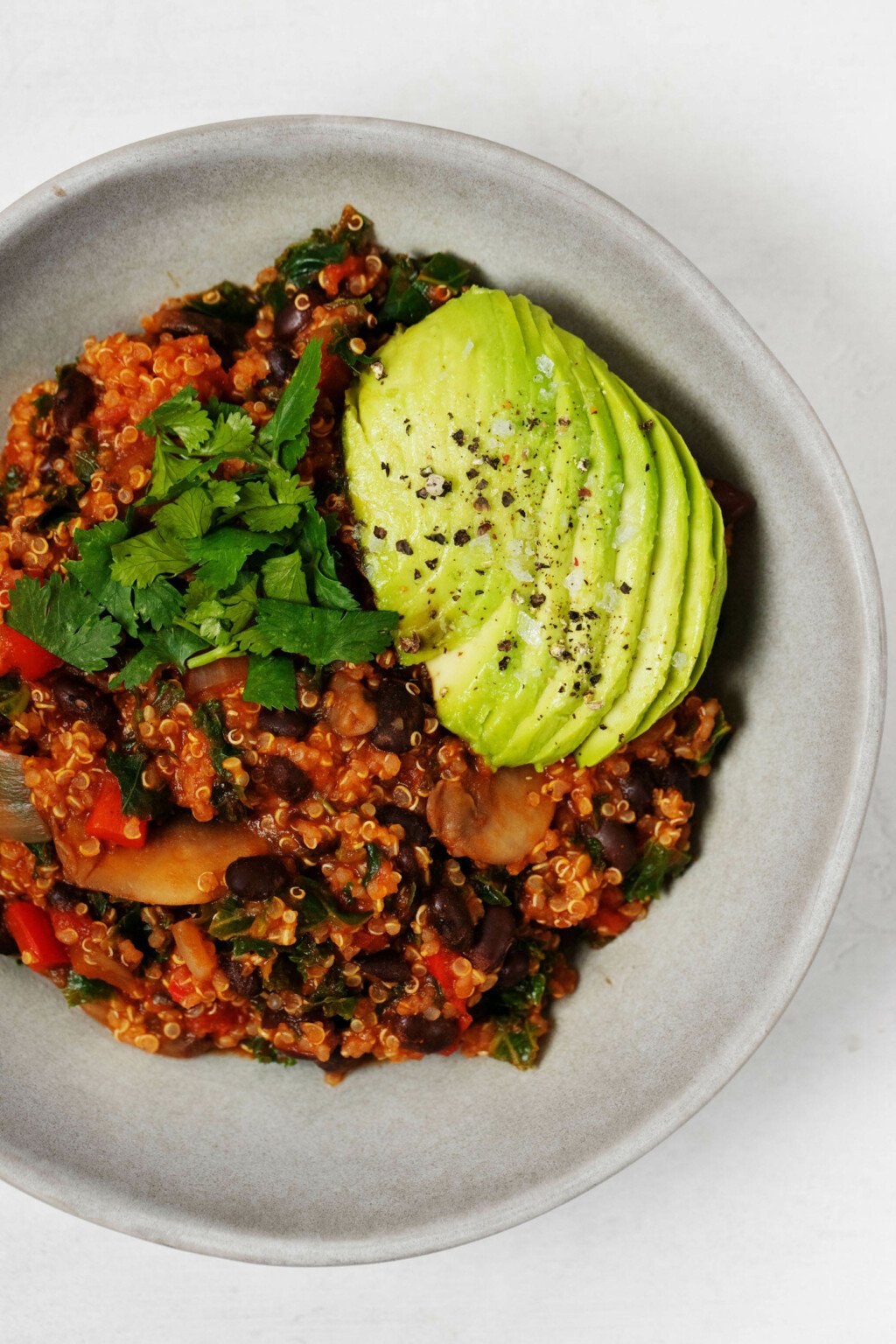
Here’s the recipe!
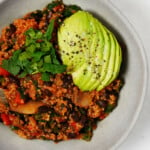
A Beginner’s Guide to Vegan Meal Prep: Black Bean Quinoa Chili
Author –Ingredients
- 1 tablespoon olive oil (substitute 1/4 cup vegetable broth to make the recipe oil-free)
- 1 white or yellow onion, chopped
- 1 poblano pepper, chopped
- 1 red or green bell pepper, seeded, stemmed, and chopped
- 8-10 ounces sliced button mushrooms
- 4 cloves garlic, minced
- 3 chipotle peppers in adobo sauce, chopped, with their liquid (reduce the amount to 2 peppers if you prefer less heat)
- 1/2 teaspoon smoked paprika
- 1 teaspoon ground cumin
- 1 teaspoon salt
- 1 cup dry quinoa, rinsed through a fine sieve (180g)
- 3 cups cooked black beans (480g, or two 15-ounce/425g cans, drained and rinsed)
- 28 ounces regular or fire-roasted, diced tomatoes, with their juices (800g)
- 4 cups vegetable broth (950ml)
- 1 cup water (240ml)
- 1 bunch curly kale, stemmed and chopped
- 2 tablespoons freshly squeezed lime juice
- 4-ingredient vegan sour cream (optional, for topping)
Instructions
- Heat the oil in a large pot over medium heat. Add the onion, peppers, and mushrooms. Sauté the vegetables, stirring often, for 10 minutes, or until the mushrooms are tender and reduced in size and the onion is clear and soft. Add the garlic and cook, stirring constantly, for another minute; add a splash or two of water at any point if the vegetables are sticking.
- Add the chipotle peppers, paprika, cumin, salt, quinoa, beans, tomatoes, broth, and water to the pot. Bring the mixture to a boil. Reduce the heat to low, cover, and simmer for 20 minutes.
- Add the kale to the pot (you may need to stir it in in batches). Re-cover the pot and cook for another 10 minutes, or until the kale is tender.
- Add the lime juice. Taste the chili; adjust salt and extra lime juice to taste. Serve with vegan sour cream, if desired.
I know that meal prep can feel like an overwhelming concept if you haven’t done it before. My hope is that this post covers just some of the basic information that you need to get started.
And if you have a question about any of this, comment and ask!
I’ve come to cherish meal prep for its capacity to keep me nourished. I love talking about it, responding to questions, and continuing to figure it out for myself along the way.
Till soon,
xo
This post may contain affiliate links. If you use these links to buy something I may earn a commission. Visit my privacy policy to learn more.
Method: One Pot
Ingredients: Black Beans, Quinoa
Dietary Preferences: Gluten Free, Soy Free, Vegan
Recipe Features: Meal Prep

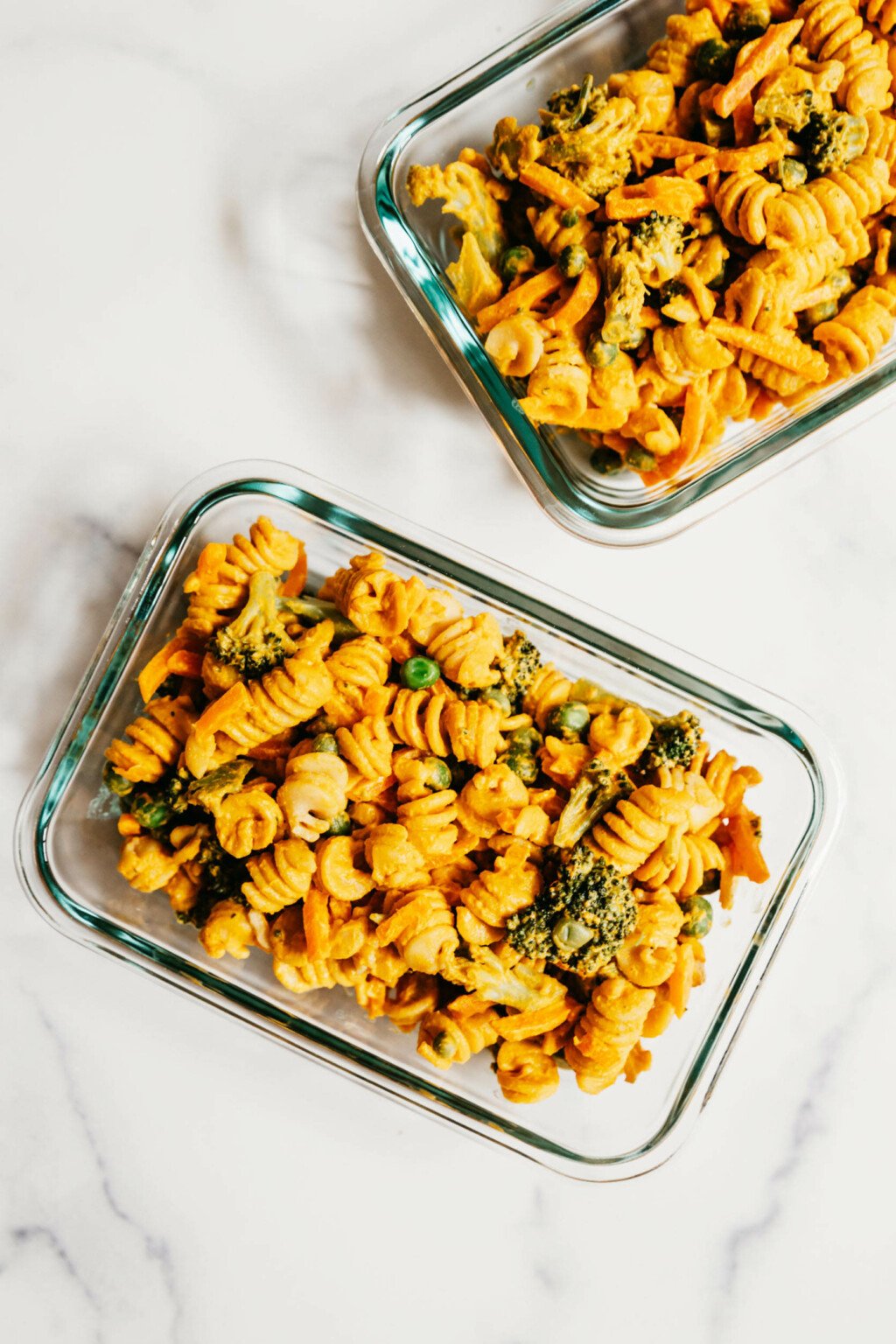
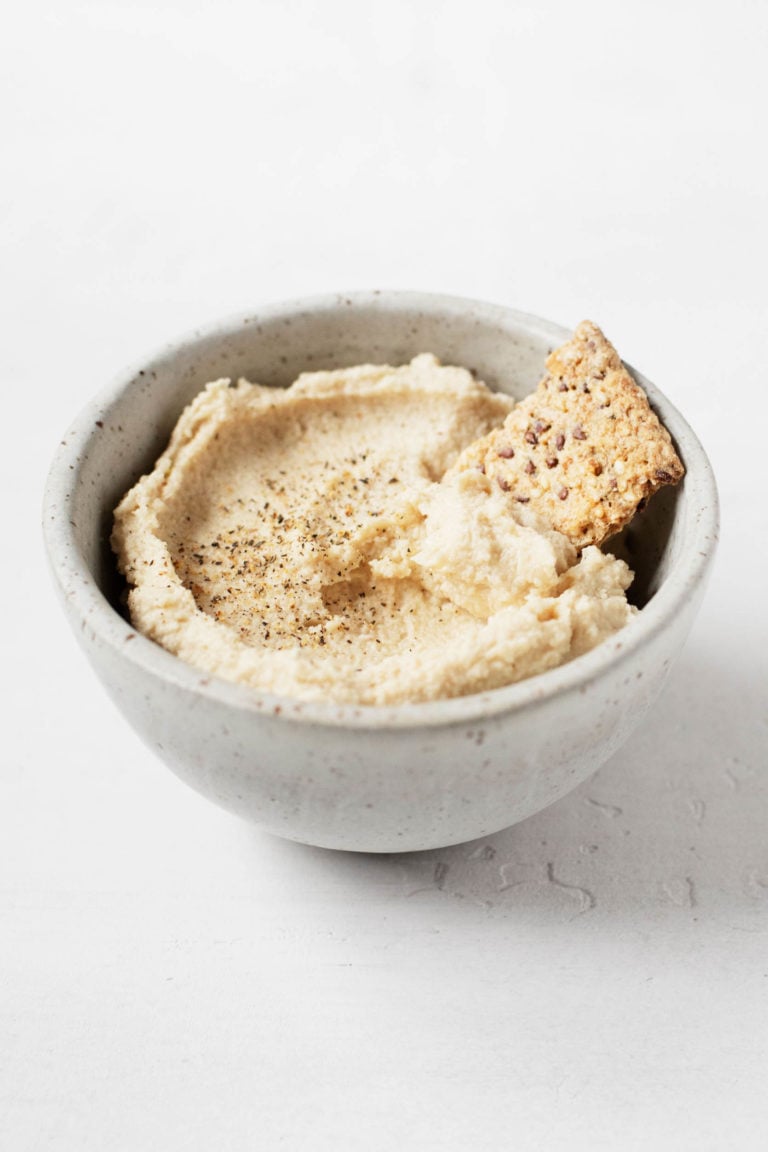
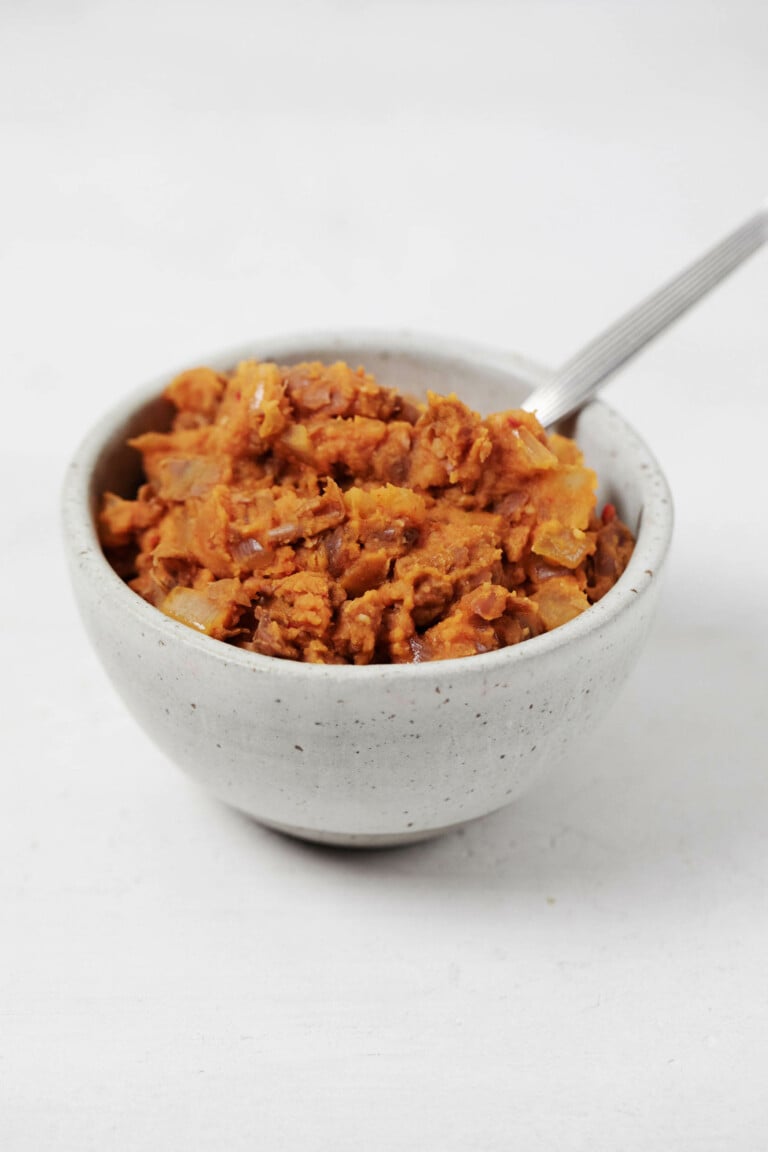
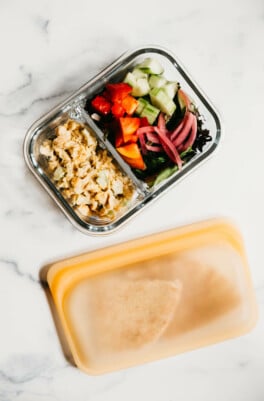
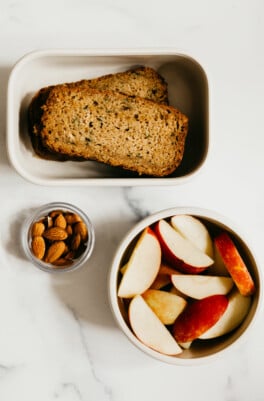
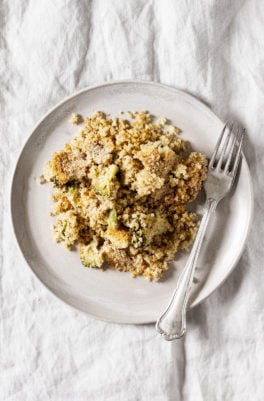
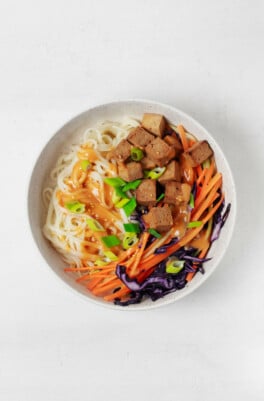
Leave a Comment
Ideally, I like the idea of meal prep. However, Ayurvedic teachings suggest that the constant drastic temperature change will deprive the food of many of the wonderful nutrients. So my tip is to prep but not cook until the day you plan to use the meal. Cut the veggies and pre measure the ingredients needed, that way it will be quick and simple when you plan to cook, while preserving all the vital nutrients of the food.